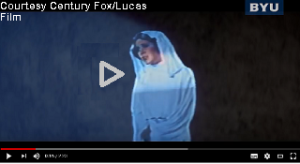
Princess Leia: Back to the Future
I know, it’s two distinct films, but Brigham Young University (BYU) seems to return to the path of broadcasting and projecting 3D holographic images into the air.
path of broadcasting and projecting 3D holographic images into the air.
“Our team’s mission is to make the 3D holograms of science fiction a reality,” said Daniel Smalley, a professor of computational engineering and computer science, a holography expert who recently published an article in Nature magazine.
The technique he developed is based on the phenomenon of photophoresis, in which particles suspended in the medium of a gaseous liquid (there are experiments with droplets of water that forces it to be sucked into the air), it can be the particles that are in the air, which need to be moved by thermal gradients and can be done by laser beams, explains Smalley, “these screens are capable of producing images in a ‘fine beam’ that are visible from any direction and are not subject to cutouts,” ie seen from any position of the viewer.
The technical name of this effect is more precisely: “photophoretic-trap volumetric display”, and is superior to old techniques that could not capture light through the air to create a virtual object with the same notion of depth as the actual object.
But the most spectacular is the possibility of RGB projection (Red-Green-Blue, the three primary colors that composed were the visible spectrum by the human being) as the point of light is able to move quickly and thus the point of light produces the color, the projection of the green, red and blue laser radios produce the visual effect of the color.
The color image in three-dimensional volumetric (3D), will have the resolution of 10-micrometer (10 ^ -6 of the meter or 10 ^ -4 of the centimeter), this means to produce 10 thousand voxels (Pixels volumétricos) by centimeter or one million by meter cubic.
In a short time the communication has changed, in 10 years we have spoken through the Web in visual interaction, thanks to VoIP (voice over Internet), now the volumetric interaction in holograms, or also, to watch images of objects and people around us that are thousands of miles of distances, or simply in filming from other times, we are back in the future.









